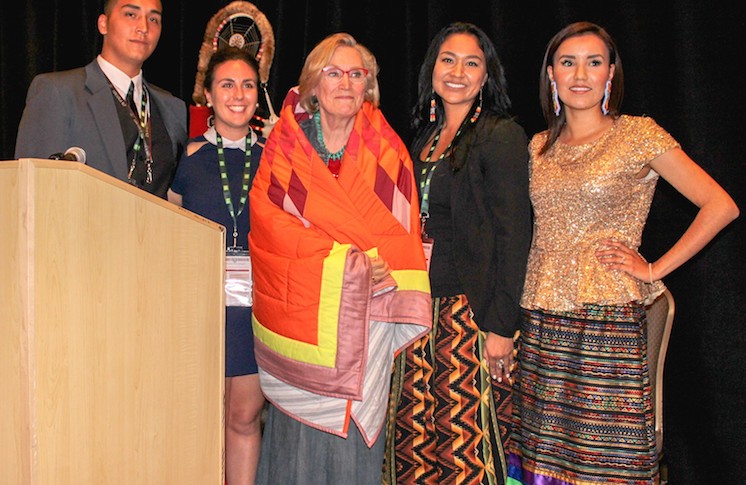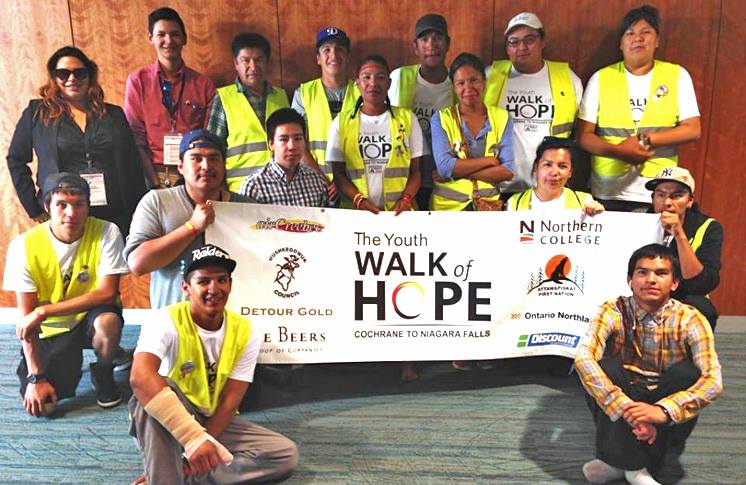
National First Nations Youth Council Gifts Quilt to Carolyn Bennett, Minister of Indigenous and Northern Affairs at Assembly of First Nations Youth Summit | Image source: Two Row Times

This past summer more than 200 First Nations youth from across the country gathered in Niagara Falls for a National Youth Summit organized by the Assembly of First Nations. The Summit was held at the Hilton Hotel and took place 252 years following the historic 1764 Treaty of Niagara, an agreement signed between the British Crown and more than twenty sovereign Indigenous Nations from the great lakes region including Haudenosaunee, Anishinaabe, Menominee, Shawnee, and Wyandot Peoples. The Treaty of Niagara is a symbol of the Indigenous title to land and illustrates the Nation-to-Nation relationship that was agreed upon in order for Canada to be founded as a nation state.
Young people from Mushkegowuk Territory walked over 800 kilometers in the hope to raise awareness about the suicide crisis affecting the Attawapiskat community and other First Nations communities across the country. The Walk of Hope was a journey that began in Cochrane, Ontario and brought the walkers to Niagara Falls, in a courageous demonstration of strength and determination. Youth-led, grassroots initiatives are powerful and express the resilience of Indigenous peoples. In recognition of the Walk of Hope, the Assembly of First Nations Youth Council honoured the walkers with gifts and words of encouragement.

It was inspirational to see so many young people who are passionate about thinking and talking about youth suicide, environmental rights, the revitalization of Indigenous languages, and cultural knowledge. Young people are taking on leadership roles and finding innovative solutions to address the needs of their communities
A youth panel comprised of Tehatsistahawi, Gwahnahjikwehns, Onawatin and Mashkode Bizhiki Washk Kwe shared their stories and encouraged people in the room to turn to culture for healing. These young people spoke of how traditional knowledge, ceremonies and cultural practices help create balance in our mind, heart, body and spirit. The full presentations are available online here: http://cultureforlife.ca/

Throughout the day, participants attended cultural and educational workshops; in the afternoon National Chief Perry Bellegarde addressed the room and the federal minister of Indigenous and Northern Affairs, Carolyn Bennett, was honoured with a quilt by the Assembly of First Nations for her commitment to reconciliation in Canada. Bennett spoke to the youth attendees, and offered some time for the youth to ask questions. I heard someone say, “Don’t these government people make enough money to buy their own blankets?”
There was a heavy presence of Health Canada at the Summit and the Heath Canada employees used the space as an opportunity to research and question youth about what services and programs “they thought” were needed to improve the health and quality of life within Indigenous communities. It was no surprise that the themes of re-visioning culture, access to education, land-security, language revitalization and education came up time and time again from the youth.
So much research is already available and the statistical reporting that the government has conducted over the past 30 plus years is enough information to warrant a change in how health inequities are addressed in Canada.
Reconciliation is an opportunity for Health Canada to create meaningful relationships with Indigenous communities and for our leaders to commit to working together in an effort to address Indigenous wellbeing, youth mental health, addictions and sexual health. It would be beneficial for Health Canada to use their resources (staff time/funding) in the interest of investing in water security, food security, and primary health services like harm reduction, in First Nations communities both on and off-reserves.

The Summit closed with an open-mic and comedy show hosted by funny man Ryan McMahon. It was inspiring to watch all the talented youth perform and share their powerful stories through spoken word, poetry, and song. Gatherings like these are important because First Nations youth connect with their peers and begin to have conversations about the challenges and shared vision of the future. As Indigenous Peoples, when we begin talking and sharing our stories, we begin to heal, learn and grow. I walked away hoping that there will be more Elder presence at the next Youth Summit and that we will see the leaders we elected being leaders for change because the young people are watching and waiting. Maybe one day our national gathering will take place in a lodge or roundhouse rather than the Hilton Hotel across from the Fallsview Casino.
The Seventh Fire is an Anishinaabe prophecy that foretells a time when Indigenous Peoples will return to their traditional knowledge bundles with the help of Elders and teachers. The 7th Fire has arrived and it is the time for the next generation to choose the path that leads to the lighting of “the Eighth and final Fire, an eternal fire of peace, love brotherhood and sisterhood…”, from the Mishomis Book: The Voice of the Ojibway by Edward Benton-Banai.









